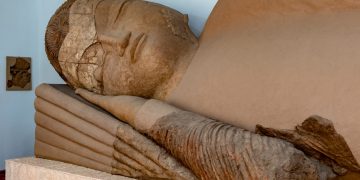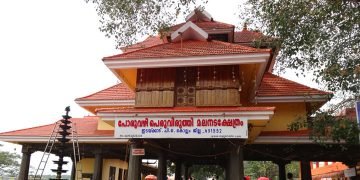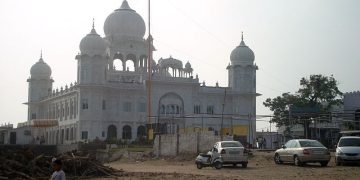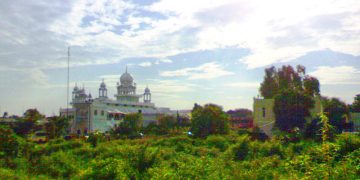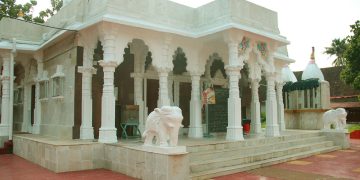Pushpagiri in Jajpur District, Odisha was an ancient Buddhist maha vihara located atop Langudi Hills. The complex contains ruins of stupas, rock-cut sculptures and other artefacts.Pushpagiri was mentioned in the writings of the Chinese traveller Xuanzang and some other ancient sources. Until the 1990s, it was hypothesised to be the Lalitgiri-Ratnagiri-Udayagiri complex, also located in Jajpur district. However, archaeological excavations conducted at Langudi Hills during 1996-2006 resulted in the discovery of another site, with inscriptions describing the local monastery as puṣpa sabhar giriya, and identified by the excavators as Pushpagiri.
Shrine’s History
Chinese traveller Xuanzang (c. 602-644) describes a sangha Rama (monastery) named Pu-se-p’o-k’i-li in the south-west region of a country, whose name is variously transliterated as U-Cha or Wu-T-U. Scholars such as Stanislas Julien and Samuel Beal restored Pu-se-po-k’i-li as “Pushpagiri”, and the name of the country as Ota or “Udra”. Scholars identify this country as Odra in present-day Odisha. Xuanzang describes the monastery as follows: In the south-west of the country was the Pu-sie-p’o-k’i-li monastery in a mountain; the stone top of this monastery exhibited supernatural lights and other miracles, sunshades placed by worshippers on it between the dome and the amalaka remained there like needles held by a magnet. A 3rd-century inscription of the
Andhra Ikshvaku king Vira-purusha-datta, found at Nagarjunakonda (in present-day Andhra Pradesh), mentions that a upasika named Bodhisiri made numerous endowments to Buddhist establishments. One of these included sponsoring the erection of a stone mandapa at “Puphagiri”. According to Thomas E. Donaldson, this is likely same as the Pushpagiri mentioned in Xuanzang’s records (“Puphagiri” being the Pali form of the Sanskrit “Pushpagiri), and was located in the present-day Odisha.Pratapaditya Pal notes that if this identification is true, the site in Odisha must have been established by at least 3rd century. However, some other scholars, such as Dineshchandra Sircar and B. S. L. Hanumantha Rao, identify this “Puphagiri” with Pushpagiri Temple Complex in the present-day Cuddapah District of Andhra Pradesh. The 9th-century Buddhist monk Prajna, after spending 18 years in various places including Nalanda, settled in an unnamed monastery of Wu-ch’a (identified with Odra), before going to China. A few scholars, such as Prabhat Mukherjee, identify this monastery with Pushpagiri.
_-_Jajpur_-_Odisha_-_Buddhist_site_-_Ancient_Stupa_0.jpg)
_-_Jajpur_-_Odisha_-_Buddhist_site_-_Stone_inscription_written_in_Pali.jpg)
Architectural Relevance of This Shrine
In the 20th century, a number of scholars identified the Pushpagiri mentioned in Xuanzang’s records with various sites in present-day Odisha. Ramaprasad Chanda (1930) of Archaeological Survey of India believed that either Udayagiri or Lalitgiri could be the historical Pushpagiri. Based on archaeological finds, K. C. Panigrahi (1961) hypothesised that Udayagiri, Lalitgiri and Ratnagiri formed a common complex, which was called Pushpagiri. N. K. Sahu (1958) identified it somewhere in the Phulbani-Ghumsur region, based on geographical descriptions in Xuanzang’s works. In 1985, the Archaeological Survey of India (ASI) started excavation at Lalitgiri to locate Pushpagiri. The excavation led to several important archaeological discoveries, but none of these confirmed the identification of Lalitgiri with Pushpagiri. In the 1990s, college lecturer Harish Chandra Prusty discovered a Buddhist site on the Langudi Hill in Jajpur district. In 1993, he and Pradeep Mohanty described the site in an article published in the Bulletin of the Deccan College Research Institute In 1996, the Orissa Institute of Maritime and South East Asia Studies and the Odisha state’s archaeology department started exploring the site.[14] Between 1996 and 2006, the Institute carried out excavations of an area stretching over 143 acres (0.58 km2). A fragmented Brahmi inscription discovered at the site names the site as puṣpa sabhar giriya (“flower-filled hill”), identified by the excavators as Pushpagiri. In 2000, an excavation conducted by the Institute, under the supervision of archaeologist Debraj Pradhan, resulted in the discovery of a large stupa as well as several other archaeological artefacts. The artefacts included pillars, a fragmentary Brahmi inscription, terracotta seals and Northern Black Polished Ware. Debraj Pradhan believed the stupa to have been erected by the Mauryan emperor Ashoka (304?232 BCE): Although Xuanzang suggests that Odra had 10 stupas erected by Ashoka, this is the only one to have been discovered so far. According to B. N. Mukherjee of Calcutta University, who deciphered the Brahmi inscription, the stupa may have been erected by “a lay Buddhist worshipper called Ashoka”. By 2007, 34 rock-cut stupas of various sizes had been discovered on the northern part of the hill. A number of Buddhist rock-cut sculptures were discovered on the southern spur of the hill, including sculptures of Dhyani Buddhas in various postures. According to D. K. Dimri, the superintendent of the ASI’s Orissa circle, the archaeological finds at the site cover a period between 1st century CE and 9th century CE, and suggest the existence of a major Buddhist monastic establishment. In 2007, the ASI took over the excavated site.
Shrine’s Map Location and How to Go There
By Road
By road Paradeep(60 kms), Jajpur Road(62 kms), Bhubaneswar(71 kms)
By Rail
Nearest Railway Station – Paradeep(60 kms), Jajpur Road(62 kms), Bhubaneswar(71 kms)
By Air
Nearest Airport -Bhubaneswar (71 kms)
Extra Information About this Shrine
The visit of Xuanzang indicates that Pushpagiri was an important Buddhist site in ancient India. Along with Nalanda, Vikramashila, Odantapuri, Takshashila and Vallabhi, it is believed to be a major ancient centre of learning. It flourished between 3rd and 11th centuries CE.



